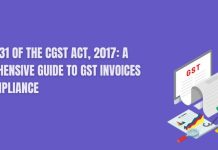Recent Updates on e-Invoicing:
10th May 2023
In line with the government’s push for a digital economy, the Central Board of Indirect Taxes and Customs (CBIC) has declared that businesses with a turnover exceeding ?5 crore from the fiscal year 2017-18 onwards will be required to generate e-invoices. This regulation, effective from August 1st, 2023, marks the implementation of the 6th phase of e-invoicing and aims to promote a more digitalized business environment.
Introduction
The introduction of Goods and Services Tax (GST) in India has revolutionized the tax landscape, streamlining processes and enhancing transparency. As part of this transformative journey, the government has introduced various measures to simplify tax compliance for businesses. One such measure is the implementation of the e-invoice system. In this blog post, we will delve into the concept of e-invoice and shed light on the e-invoice limit under GST.
Understanding E-Invoice:
An e-invoice is an electronic document that contains all the details of a commercial transaction between a supplier and a buyer. It replaces the traditional physical paper-based invoices and brings automation to the invoicing process. The e-invoice system was introduced under the GST regime to bring efficiency, reduce errors, and curb tax evasion.
E-Invoice Limit:
The e-invoice limit refers to the turnover threshold above which businesses are required to generate e-invoices for their transactions. The limit determines the applicability of the e-invoice system and helps streamline tax compliance for businesses.
As of my knowledge cutoff in September 2021, the e-invoice limit under GST was set at INR 500 crore (5 billion) annual turnover for businesses. However, it’s important to note that tax regulations are subject to change, and it is recommended to verify the latest e-invoice limit with the official GST portal or consult a tax professional for up-to-date information.
Benefits of E-Invoice:
- Seamless Data Integration: The e-invoice system facilitates seamless integration of invoice data with the GST portal, reducing manual data entry and eliminating transcription errors. This integration helps in auto-populating the details in various GST returns, simplifying the compliance process.
- Reduced Tax Evasion: E-invoices contain a unique Invoice Reference Number (IRN) generated by the GST Network (GSTN). This unique identification helps in validating the authenticity of the invoice and reduces the possibility of fake or duplicate invoices. It ensures transparency and helps in curbing tax evasion.
- Enhanced Efficiency: By automating the invoicing process, e-invoices save time and effort for businesses. It eliminates the need for physical paperwork, reduces the risk of lost or misplaced invoices, and improves overall operational efficiency.
- Better Cash Flow Management: E-invoices provide real-time visibility into transaction details and enable faster processing of invoices. This, in turn, facilitates quicker payments, leading to better cash flow management for businesses.
Implementation and Compliance:
To generate e-invoices, businesses need to comply with the technical specifications laid out by the GSTN. They must integrate their billing systems with the GST portal or use third-party software providers authorized by the GSTN. The e-invoice must contain specific mandatory fields and adhere to the prescribed format.
Conclusion
The e-invoice system under GST is a significant step towards digitizing tax compliance and promoting transparency in commercial transactions. While the e-invoice limit determines the threshold for businesses to adopt this system, it is crucial to stay updated with the latest regulations and guidelines provided by the GSTN. Embracing e-invoicing brings numerous benefits to businesses, including streamlined operations, reduced tax evasion, and improved compliance efficiency. By leveraging technology, businesses can adapt to these changes and simplify their tax compliance processes in the long run.
Read more useful content:
Frequently Asked Questions (FAQs)
Q1: What is the e-invoice limit under GST?
A1: As of my knowledge cutoff in September 2021, the e-invoice limit under GST was set at INR 500 crore (5 billion) annual turnover for businesses. However, it is advisable to check the latest e-invoice limit with the official GST portal or consult a tax professional for the most up-to-date information.
Q2: Does the e-invoice limit apply to all businesses?
A2: No, the e-invoice limit applies only to businesses whose annual turnover exceeds the specified threshold. Businesses with turnover below the e-invoice limit are not required to generate e-invoices for their transactions.
Q3: How is the turnover calculated for determining the e-invoice limit?
A3: The turnover for calculating the e-invoice limit includes the aggregate turnover of all supplies made by a taxpayer, whether taxable, exempt, or zero-rated. It is important to consider the turnover of all registered entities under the same PAN while determining the applicability of the e-invoice limit.
Q4: What happens if a business crosses the e-invoice limit during the financial year?
A4: If a business crosses the e-invoice limit during a financial year, it becomes liable to generate e-invoices for all its transactions from the month following the month in which the limit is exceeded. The business should ensure compliance with the e-invoice requirements as per the guidelines provided by the GSTN.
Q5: Can a business voluntarily opt for e-invoicing even if its turnover is below the e-invoice limit?
A5: Yes, businesses that fall below the e-invoice limit can voluntarily opt for e-invoicing. While it may not be mandatory for them, they can choose to implement e-invoicing to enjoy the benefits of automation, efficiency, and better compliance management.
Q6: Are there any penalties for non-compliance with the e-invoice limit?
A6: Non-compliance with the e-invoice limit and failure to generate e-invoices as required can attract penalties and fines as per the provisions of the GST Act. It is advisable for businesses to stay updated with the regulations and ensure timely compliance to avoid penalties.
Q7: Is the e-invoice limit the same for all types of businesses?
A7: Yes, the e-invoice limit applies uniformly to all businesses, regardless of their size, sector, or type of operations. The limit is based on the annual turnover of a business and determines the applicability of the e-invoice system.




















